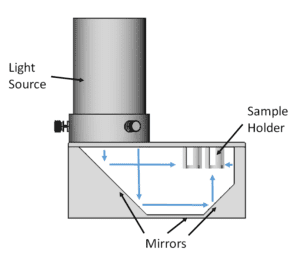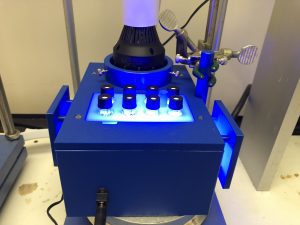Photoreactor Setup and Design
With a interest for photochemistry that has been growing exponentially in recent years. Photoreactor setup and design are becoming critical to perform accurate and reproducible photochemistry experiments. Numerous new applications using visible-light photoredox catalysis have been discovered. These new catalytic systems can perform many types of bond formations using various substrates which are valuable new tools for synthetic chemists.
Home-made Photoreactor Setup
 Recent photoredox chemistry necessitates to the use of light sources and apparatus that are not often available in an standard organic chemistry laboratory. Therefore many chemists have made their own setup and tried to reproduce literature chemistry with more or less success. As a result, the implementation of photoredox chemistry is slow and organic chemists are still hesitant to try these important new tools. Therefore, the need for a simple and robust device to perform visible-light photoredox catalysis has become increasingly important.
Recent photoredox chemistry necessitates to the use of light sources and apparatus that are not often available in an standard organic chemistry laboratory. Therefore many chemists have made their own setup and tried to reproduce literature chemistry with more or less success. As a result, the implementation of photoredox chemistry is slow and organic chemists are still hesitant to try these important new tools. Therefore, the need for a simple and robust device to perform visible-light photoredox catalysis has become increasingly important.
EvoluChem™ Photoreactor
The EvoluChem™ PhotoRedOx Box was designed with one main objective: To allow any chemist to easily perform multiple photochemical reactions in a reproducible environment. Therefore, our photoreactor provides an even light distribution to all reaction samples allowing consistent and reproducible reactions. Additionally, a cooling fan allows even temperature distribution and keeps the chamber near room temperature during long reaction runs. Moreover, this photoreactor easily fits on standard stir plates, allowing for consistent stirring. Sample holders are compatible with vials ranging from 0.3 ml to 20 ml vials.
Unique Photoreactor Design
The PhotoRedOx Box is using a unique geometry of mirrors to irradiate multiple samples simultaneously for parallel chemistry setup while limiting the thermal effect of the light source. As a result, this design permits a compact photoreactor which can be easily set on any standard stir plate.
In addition, the lamp adapter allows easy switching from the standard kessil™ blue 34W LED lamp to other EvoluChem light sources design by HepatoChem.

Fit multiple vial formats
Because organic chemists needs to be able to use different reaction vial sizes depending on the scale and the number of the reaction to be performed. The PhotoRedox Box can virtually fit any type of vials including 0.3ml crimped vials (6 x 32mm), 2ml HPLC vials (12 x 32mm), 1DRAM (15 x 45mm), Microwave vial 2-5mL (17 x 83mm), 2DRAM (17 x 60mm) and 20ml scintillation vials (28 x 61mm). Most importantly, this feature allows quick and consistent scale up from screen reactions to larger scale with preset sample positions removing the guess work on sample placement distance from the light source. When using 0.3 ml vials, 32 reactions can be performed in parallel in the photochemical reactor. At 20 ml scale, two reactions can be run in duplicate.
Reproducibility
Using a EvoluChem photomethylation kit, we have demonstrated the reproducibility of both the photomethylation kit and the device. With the photomethylation of buspirone as test reaction, 16 vials spread through the 0.3 ml vial sample holder for Trial #1 results in 53% (+/-2 %) conversion. See figure. Additionally, a second trial with 16 reaction vials shows an average conversion of 56% (+/-2 %) for the mono-methylated product.
Test reaction (Methylation)
photomethylation reaction

Percentage of mono-methylation product
by reaction vial position reproducibility_photomethylation
Average- 53% +/-2%

Reaction conditions:
Each reaction vial contains Ir(dF-CF3-ppy)2(dtbpy)[PF6] (0.1 μmol), tert-butylperacetate solution (12.5 μmol) and a stir bar sealed under inert atmosphere. To each vial was added 50 μl of 0.05 M buspirone solution in 1:1 trifluoroacetic acid/acetonitrile sparged with nitrogen stream. Reaction mixture irradiated with EvoluChem LED 450nm HCK1012-01-002 for 18 hr using EvoluChem photoreactor.

